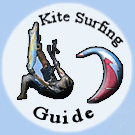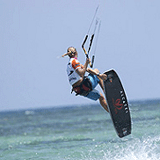Lines
It would be a good idea to know all about the lines and the bars on a kite, eventhough you won't have to buy them separately, as kites nowadays are sold together with the lines and the bar.
Depending on the type of kite a kitesurfer uses, the number of lines vary. Kites can have 2, 3 or 4 lines. Some of them have two different systems at a time: a 2-line system and a 4-line one, but most of them have either 2-line or a 4-line system. Most commonly, kites used by kitesurfers have two systems, one for simplicity : the 2-line system, and the other for more control over the kite: the 4-line system. With the aid of a 4-line you can, for example, depower the kite during a gust.
Line Type
Kitesurfing can be done properly with almost any traction kite. the important thong is to know what type of lines to get for it. Here are a few tips:
- Spectra , that is Dyneema if you live in Europe or Kevlar lines can only stretch 4% and that is not a good thing compared to other line types.
- Floatable lines are good to have when kitesurfing.
- The main lines should be 400 - 500 lb. lines and the brake lines should be 200 lb. Remember that the main lines are the lines in a 2-line kite or the 2 front lines in a 4-line foil and the brake lines are 2 back lines in a 4-line foil. In case you are using a a 4 line inflatable, which has no brake lines, you should get 400 - 500 lb. lines for all the 4 lines.
Line Strength
Line strength is actually very dependable on your weight. Should you have a 2-line kite, use lines having a minimum strength equals to 2.5 times your weight. Should you have a 4-line foil, use main lines of a minimum strength equal to 2.5 times your weight, and brake lines of a minimum strength equal to your weight. So, if your weight is 200 lb., your lines must be at least 500 lb. lines for your 2 line kites and 500 lb. main lines, 200 lb. brake lines for your 4 line foils. Inflatable kites require that the two front lines have the same strength as the two back lines.
Knots, Sleeves & Splice
You have to make a lark's head knot at the end of the line in order to tie your lines to the bridle or the control device. Spectra and Kevlar need sleeving, as their lines cannot be tied directly onto itself. Note that the sleeve is a small piece of Dacron hollow line that a Spectra or Kelvar line goes through. 2 overhand knots or 8 figure knots are tied in that section, in order to reduce about 30 - 40 % the strength of the lines. One of the first kitesurfers, Dave Culp, has tested this. Should you use knots, you must multiply the line strength figures by a factor of 3/2.
Another thing you can do is to form a loop by sewing the sleeved lines. This is how it can be properly done:
- At the end of a line must be put a 30 cm sleeve.
- Form a 15 cm loop by folding the sleeved portion.
- Sew the two sleeved lines together noting that the needle should go through both the sleeve and the line. Use a small zig-zag pattern to do this. You must have a small 3 cm loop at the end, so sew only 12 cm.
Sleeved lines retain their original strength, if we were to trust most kitesurfers.
A solution posted on the Kitesurfing mailing list by Roberto, Optikites, is to splice your lines to form a loop. This is how you do it:
1. Push with your hands to open the wove, because lines get stretched.
2. The end of the line must be thread its own core for 5 inches.
3. Milk to make the line even.
4. Again thread another 5 inches inside the core and milk once more.
5. The last two steps finish the job. A tip to follow would be to slip in the loop some Dacron sleeve before splicing. This could make a better job.
When you have a broken line that needs repairing, do as follows:
- Starting from 10 – 15 inches below, push one end inside the core of the other end of the line.
- Do the same for the other 15 inches left on the other line.
- Milk the line so that it gets even, and should you have done a fine job, the repaired line will look as good as new.
Line Length
Line length is a function of the size of the kite you are using and of course varies with the wind strength of the area where you want to kitesurf. Usually, kitesurfers have 20 m to 40 m long lines. The main thing is to have shorter lines should you be overpowered and longer lines should you be underpowered. The short lines reduce the risk of the kite picking up extreme speed that can generate uncontrollable power, by restricting the flight path of the kite, that is called the wind window of a kite. Longer lines increase the kite flight path to enable the kite to gather more speed for more power, and all that by extending the wind window.
Kitesurfers commonly use 25 m to 30 m lines, because these are most suited for starting, going upwind and for jumping. Should you want a more thrilling experience, try lines of various lengths. By doing this, you may also find out that another line length is more suitable for you than a 25 m to 30 m standard line.
Nevertheless, kitesurfers tend to using shorter than standard line types, that is 20 m to 25 m long lines, thus reducing the space they need when kitesurfing.


